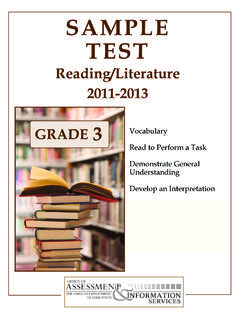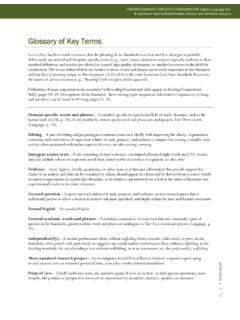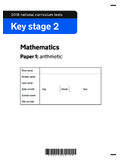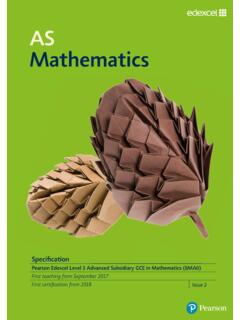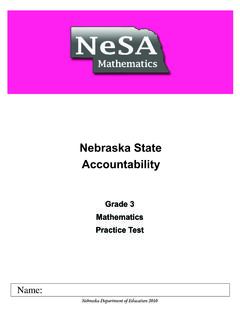Transcription of Mathematics Sample Test Grade 8 2010-2013
1 MATHEMATICSSAMPLE TESTGRADE 82007 Oregon Content StandardsGrades 3 - 8It is the policy of the State Board of Education and a priority of the Oregon Department of Education that there will be no discrimination or harassment on the grounds of race, color, sex, marital status, religion, national origin, age or handicap in any educational programs, activities, or employment. Persons having questions about equal opportunity and nondiscrimination should contact the State Superintendent of Public Instruction at the Oregon Department of Education. Office of Assessment & Information Services Oregon Department of Education 255 Capitol Street NE Salem, OR 97310 (503) 947-5600 Susan Castillo State Superintendent of Public Instruction Leslie Phillips Science and Social Sciences Assessment Specialist Doug Kosty Assistant Superintendent James Leigh Mathematics Assessment Specialist Tony Alpert Director, Assessment and Evaluation Dianna Carrizales Director, Monitoring, Systems, and Outcomes Steve Slater Manager, Scoring, Psychometrics and Validity Bradley J.
2 Lenhardt Monitoring and Assessment Specialist Kathleen Vanderwall Manager, Test Design and Administration Sheila Somerville Electronic Publishing Specialist Holly Carter Assessment Operations and Policy Analyst Kathy Busby Project Manager Ken Hermens Language Arts Assessment Specialist Office of Assessment and Information Services i 2010 2011 Sample tests Oregon Department of Education January 2011 INTRODUCTION TO Mathematics KNOWLEDGE AND SKILLS Grade -LEVEL Sample TESTSBACKGROUND The Oregon Department of Education provides Sample tests to demonstrate the content and types of questions students in grades 3, 4, 5, 6, 7, 8, and High School might encounter on the Oregon Assessment of Knowledge and Skills (multiple-choice), which is administered each year. ELIGIBLE CONTENT These Sample questions were taken from tests given in previous years. They were originally written to align to the 2002 Oregon Mathematics Grade -level Content Standards.
3 A panel of content experts studied the items and selected the ones which best align to the 2007/2009 Mathematics Content Standards for grades 3-8 and high school. New for 2010-11, scores are reported out at three Score Reporting Categories each year. The titles of these SRCs changes from year to year, but describes the content for each year in general terms. The chart shows the SRCs for all Grade levels. Score Reporting Category 1 Score Reporting Category 2 Score Reporting Category 3 3 : Number and Operations : Number and Operations, Algebra, and Data Analysis : Geometry and Measurement 4 : Number and Operations : umber and Operations and Algebra : Measurement 5 : Number and Operations and Data Analysis : Number and Operations and Algebra : Geometry, Measurement, and Algebra 6 : Number and Operations : Number and Operations and Probability : Algebra 7 : Number and Operations and Algebra : Number and Operations, Algebra and Geometry : Measurement and Geometry 8 : Algebra : Data Analysis and Algebra : Geometry and Measurement HS : Algebra and Numeracy : Geometry : Data Analysis As in the operational assessment, students are strongly encouraged to use the calculator with which they are most familiar when taking the Sample test.
4 The answer key provided at the end of the Sample test booklet identifies which of these categories each question is designed to assess. Office of Assessment and Information Services ii 2010 2013 Sample tests Oregon Department of Education January 2011 The same weighting across the three Score Reporting Categories of Mathematics content is used in both Sample and operational tests , as much as possible. This chart shows the approximate percent weighting of SRCs by Grade level: Grade Score Reporting Category 1 Weight Score Reporting Category 2 Weight Score Reporting Category 3 Weight 3 Number and Operations 35% Number and Operations, Algebra, and Data Analysis 35% Geometry and Measurement 30% 4 Number and Operations 35% Number and Operations and Algebra 35% Measurement 30% 5 Number and Operations and Data Analysis 35% Number and Operations and Algebra 35% Geometry, Algebra, and Measurement 30% 6 Number and Operations 35% Number and Operations and Probability 35% Algebra 30% 7 Number and Operations and Algebra 35% Number and Operations, Algebra and Geometry 35% Measurement and Geometry 30% 8 Algebra 40% Data Analysis and Algebra 30% Geometry and Measurement 30% HS Algebra 50% Geometry 30% Statistics 20% WHY PROVIDE STUDENTS WITH A Sample TEST?
5 Most students feel some anxiety as they approach a test. It is important that students know what to expect when they take the OAKS tests . The Sample tests are intended to help students approach the state tests with confidence comfortable with the test format and familiar with test-taking strategies to help them achieve the best possible score. CONTENTS OF THE Sample TEST: This overview of the purpose for Sample tests is followed by a list of test-taking tips. The Sample test formatting is similar to that of the operational OAKD Online Mathematics test. A fill-in-the-bubble answer sheet for the students to use follows the actual Sample test. The answer key identifies the correct answer, the score reporting category represented, and the code of the content standard to which the item aligns. The Sample test has fewer items than the actual assessment, and may not be used in place of the operational assessment.
6 Office of Assessment and Information Services iii 2010 2013 Sample tests Oregon Department of Education January 2011 USING THE Sample TEST: Teachers often have their students take the test as a practice activity in preparation for the actual Statewide Assessment. The answer key could be removed prior to making copies of the Sample test for student practice. Copies of the answer key could then be provided to students to check their work or to take home and share with parents. It is important to remember that students are encouraged to use their calculators and any Mathematics manipulatives on the test. Providing these tools in class and encouraging students to use them during the Sample test may be very beneficial in encouraging students to take their time and use the appropriate tools to help them solve problems during the actual test administration.
7 In fact, teachers may want to demonstrate how various tools could be used to solve the multiple-choice problems as part of the practice test activities. Teachers may use the overall class results to target areas of instruction needing further attention. Parents may find the Sample test helpful in clarifying the types of questions their child will encounter on the multiple-choice test. Parents could also assist their child in preparing for the test by practicing at home. The list of test-taking tips gives parents suggestions on ways to reduce test anxiety and promote good study and health habits in preparation for testing. Students may wish to use the test independently to practice before the actual test administration, checking their own responses against the answer key provided at the end of the booklet. Students may benefit from re-reading the problems and analyzing both the correct and incorrect answers to the multiple-choice questions they missed.
8 Building principals, superintendents, district testing coordinators, curriculum leaders and others may find the Sample test useful in communicating with parents, school site councils, and other community members. Parts of the Sample test could be included in a newsletter or shared at meetings of local community groups to help constituents better understand the state assessment system. Although the Sample tests are not as comprehensive as the complete tests administered in the Statewide Assessment, they do provide a sampling of the subject area content and difficulty levels students may encounter as a part of Oregon s high academic standards. Assessment Conditions If the practice test is to be administered in test-like conditions, the following steps need to be followed: post a testing, do not disturb sign on the window or door of the classroom go over any directions ( , students are to complete the entire test or only a portion of the test at one sitting) expect the students to work by themselves with no talking during the assessment Office of Assessment and Information Services iv 2010 2013 Sample tests Oregon Department of Education January 2011 monitor student activities during the assessment provide any of the appropriate accommodations or modifications students use during instruction and might need during testing expect all students to participate TEST-TAKING TIPS BEFORE THE TEST Develop a positive attitude.
9 Tell yourself, I will do my best on this test. Get a good night s sleep the night before the test. Get up early enough to avoid hurrying to get ready for school. Eat a good breakfast (and lunch, if your test is in the afternoon). DURING THE TEST Stay calm. Listen carefully to directions. Read each test question and all the answer choices carefully. Eliminate any obvious wrong answers Solve the problem using paper and pencil, a calculator or by using manipulatives. See if your answer is similar to one of the choices given. Pace yourself. If you come to a difficult question, it may be better to skip it and go on. Then come back and focus on the difficult questions one at a time. Just like the Statewide Assessment, this is not a timed test. If you need more time to finish the test, notify your teacher. Remember the test questions are not necessarily arranged by difficulty.
10 If you get to a question you think is too hard, that doesn t mean the rest of the test questions will also be too hard. The teachers who write the test questions use commonly made mistakes to identify good distractors, so finding an answer like yours is not a guarantee that it is the correct answer. wlhbA = lwA = bhAREA (A)MEASUREMENTSSURFACE AREA (SA) and VOLUME (V)rrhA = r2C = 2 r = dV = r 2h = BhSA = 2 r h + 2 r2SA = 4 r2V =r343whb1b2lV = lwh = BhSA = 2 (lw + wh + lh)hA = h (b1+b2)12V = Bh13d = (x2 - x1) + (y2 - y1)22SA = ( r l)+a2+ b2= c2bca r2) (xydA = bh12hbdB = Area of BaseB = Area of BaseO cial Formula Sheet and Conversion TableGrades 6 - 8V = BhSA = Sum of Areas of all facesSA = Sum of Areas of all facesB = Area of BaseB = Area of BaseB = Area of Base(x1, y1)(x2, y2)xy(x1, y1)(x2, y2)y2 - y1x2 - x1 Slope: m =BhBhrlrBhB13V = ( = Bhr2)(h)




